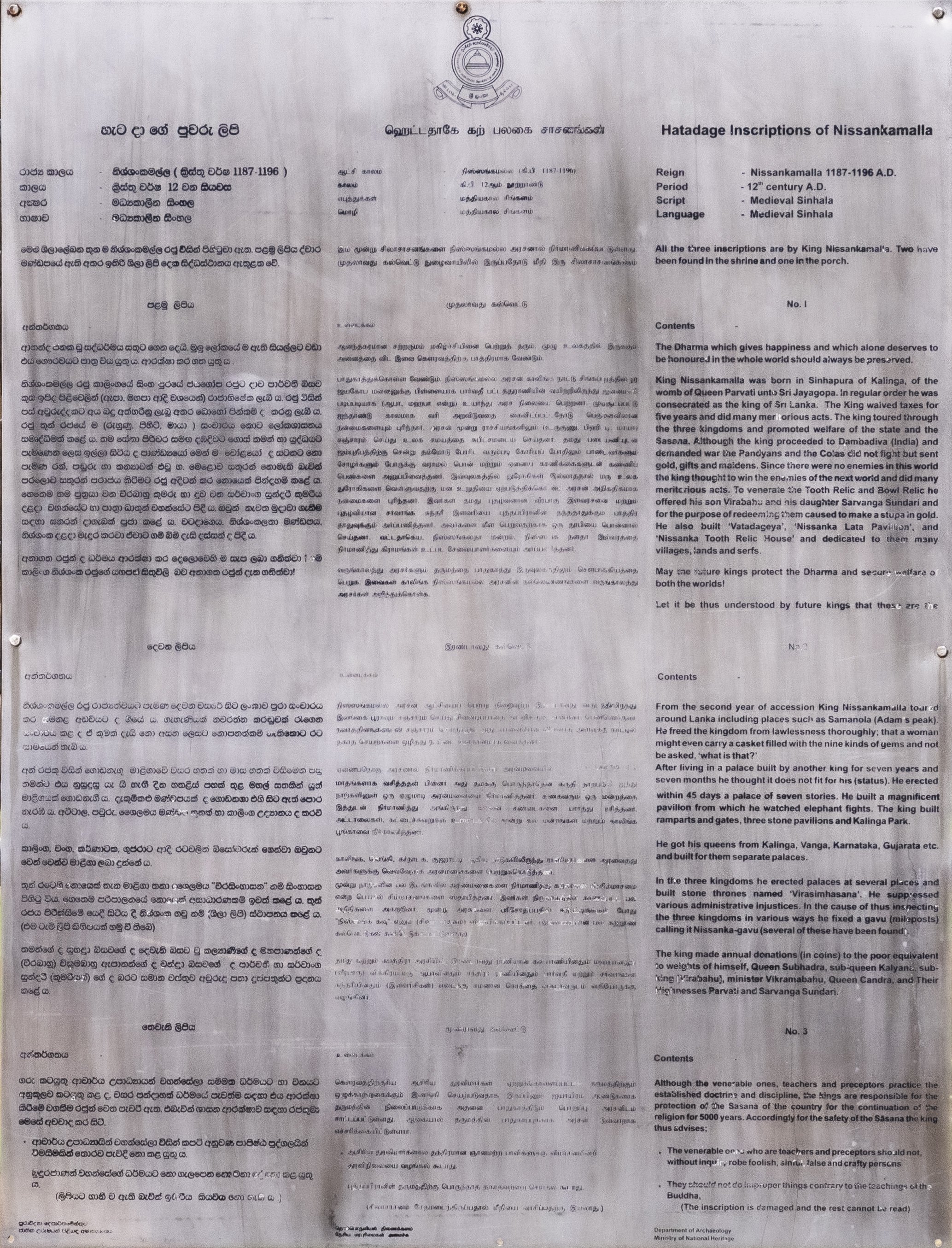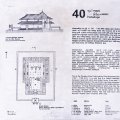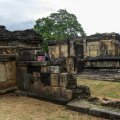Polonnaruwa (ancient city): photo 28
Photo 28 of 64 in Gallery: Polonnaruwa (ancient city)

Image title: Hatadage Inscriptions of Nissanka-Malla
Description of the photo
English text:
Hatadage Inscriptions of Nissankamalla (Nissanka-Malla)—
Reign — Nissankamalla 1187-1196 A.D.
Period — 12th century A.D.
Script — Medieval Sinhala
Language — Medieval Sinhala
All the three inscriptions are by King Nissankamalla. Two have been found in the shrine and one in the porch.
No. I (Contents):
The Dharma which gives happiness and which alone deserves to be honoured in the whole world should always be preserved.
King Nissankamalla was born in Sinhapura of Kalinga, of the womb of Queen Parvati unto Sri Jayagopa. In regular order he was consecrated as the king of Sri Lanka. The King waived taxes for five years and did many meritorious acts. The king toured through the three kingdoms and promoted welfare of the state and the Sasana. Although the king proceeded to Dambadiva (India) and demanded war the Pandyans and the Colas did not fight but sent gold, gifts and maidens. Since there were no enemies in this world the king thought to win the enemies of the next world and did many meritorious acts. To venerate the Tooth Relic and Bowl Relic he offered his son Virabahu and his daughter Sarvanga Sundari and for the purpose of redeeming them caused to make a stupa in gold. He also built 'Vatadageya', 'Nissanka Lata Pavillion', and 'Nissanka Tooth Relic House' and dedicated to them many villages, lands and serfs.
May the future kings protect the Dharma and secure welfare of both the worlds!
Let it be thus understood by future kings that these are the [???]
No. 2 (Contents)
From the second year of accession King Nissanka-Malla toured around Lanka including places such as Samanola (Adam’s peak). He freed the kingdom from lawlessness thoroughly; that a woman might even carry a casket filled with the nine kinds of gems and not be asked, 'what is that?'
After living in a palace built by another king for seven years and seven months he thought it does not fit for his (status). He erected within 45 days a palace of seven stories. He built a magnificent pavillon from which he watched elephant fights. The king built ramparts and gates, three stone pavilions and Kalinga Park.
He got his queens from Kalinga, Vanga, Karnataka, Gujarata etc. and built for them separate palaces.
In the three kingdoms he erected palaces at several places and built stone thrones named 'Virasimhasana'. He suppressed various administrative Injustices. In the cause of thus inspecting the three kingdoms in various ways he fixed a gavu (mileposts) calling it Nissanka-gavu (several of these have been found).
The king made annual donations (in coins) to the poor equivalent to weights of himself, Queen Subhadra, sub-queen Kalyana, sub-king [Virabahu], minister Vikramabahu, Queen Candra, and Their Highnesses Parvati and Sarvanga Sundari.
No. 3 (Contents)
Although the venerable ones, teachers and preceptors practice the established doctrine and discipline, the kings are responsible for the protection of the Sasana of the country for the continuation of the religion for 5000 years. Accordingly for the safety of the Sasana the king thus advises;
-) The venerable or who are teachers and preceptors should not, without inquiry, robe foolish, sinful, false and crafty persons
-) They should not do improper things contrary to the teachings of the Buddha,
(The inscription is damaged and the rest cannot be read)
Sinhalese text (not proofread):
හැට දා ගේ පුවරු ලිපි
රාජ්ය කාලය — නිශ්ශංකමල්ල (ක්රිස්තු වර්ෂ 1187-1196 )
කාලය — ක්රිස්තු වර්ෂ 12 වන සියවස
අක්ෂර — මධ්ය කාලීන සිංහල
භාෂාව — මධ්යකාලීන සිංහල
මෙම ශිලාලේඛන තුන ම නිශ්ශංකමල්ල රජු විසින් පිහිටුවා ඇත. පළමු ලිපිය ද්වාර මණ්ඩපයේ ඇති අතර ඉතිරි ශිලා ලිපි දෙක සිද්ධස්ථානය ඇතුළත වේ.
පළමු ලිපිය (අන්තර්ගතය)
ආනන්ද ථනක වු සද්ධර්මය සතුට ගෙන දෙයි. මුලු ලෝකයේම ඇති සියල්ලට වඩා එය ගෞරවයට පොතු විය යුතුය. ආරක්ෂා කර ගත යුතුය.
නිශ්ශංකමල්ල රජු කාලිංගයේ සිංහ පුරයේ ජයගෝප රජුට දාව පාර්වතී බිසව කුස ඉපිද පිළිවෙලින් (ඇපා, මහපා ආදී වශයෙන්) රාජාභිෂේක ලැබීය. රජු විසින් පස් අවුරුද්දකට අය බදු අත්හරිනු ලැබු අතර බොහෝ පින්කම් ද කරනු ලැබීය. රජු තුන් රජයේ ම (රුහුණු, පිහිටි, මායා) සංචාරය කොට ලෝක ශාසනය සමෘද්ධිමත් කළේ ය. තම සේනා පිරිවර සමඟ දඹදිවට ගොස් තමන් හා යුද්ධයට පැමිණෙන ලෙස ඉල්ලා සිටිය ද පාණ්ඩ්යයෝ මෙන් ම වෝළයෝ ද සටනට නො පැමිණ රන්, පඬුරු හා කන්යාවන් එවූ හ. මෙළොව සතුරන් නොමැති බැවින් පරලොව සතුරන් පරාජය කිරිමට රජු අදිටන් කර නොයෙක් පින්දහම් කළේ ය. හෙතෙම තම පුත්රයා වන රබාහු කුමරු හා දුව වන සර්වාංග සුන්දරි කුමරිය දළදා වහන්සේට හා පාත්රා ධාතූන් වහන්සේට පිදී ය. ඔවුන් නැවත මුදාවා ගැනීම සඳහා ඝනරන් දාගැබක් පුජා කළේ ය. වටදාගෙය. නිශ්ශංකලතා මණ්ඩපය. නිශ්ශංක දළදා මැදුර කරවා ඒවාට ගම බිම් දැසි දස්සන් ද පිදීය.
අනාගත රජුන් ද ධර්මය ආරක්ෂා කර දෙලොවෙහි ම සැප ලබා ගනිත්වා මි කාලිංග නිශ්ශංක රජුගේ යහපත් සිතුවිලි බව අනාගත රජුන් දැන ගනිත්වා!
දෙවන ලිපිය (අන්තර්ගතය)
නිශ්ශංකමල්ල රජු රාජ්යත්වයට පැමිණ දෙවන වසරේ සිට ලංකාව පුරා සංචාරය කර මනළ අඩවියට ද ගියේ ය. ගැහැණියක් නවරත්න කරඬුවක් රැගෙන සංවාරය කළ ද ඒ කුමක් දැයි නො අසන ලෙසට නොපනත්කම් නැතිකොට රට සාමයෙන් තැබීය.
අන් රජකු විසින් ගොඩනැගූ මාළිගාවේ වසර හතක් හා මාස හතක් විසිමෙන පසු තමන්ට එය නුසුදුසු යැයි හැඟී දින හතළිස් පහක් තුළ මහල් සතකින් යුත් මාළිගයක් ගොඩනැගී ය. දැකුම්කළු මණ්ඩපයක් ද ගොඩනගා එහි සිට ඇත් පොර නැරඹීය. අට්ටාල, පවුරු, ශෛලමය මණ්ඩ තුනක් හා කාලිංග උද්යානය ද කරවී
කාලිංග, වංග, කර්ණාටක, ගුජරාට ආදී රටවලින් බිසෝවරුන් ගෙන්වා ඔවුනට වෙන් වෙන්ට මාළිගා ලබා දුන්නේය.
තුන් රටෙහි නොයෙක් තැන මාළිගා තනා ශෛලමය "වීරසිංහාසන” නම් සිංහාසන පිහිටු විය. ගෙතෙම පරිපාලනයේ නොබෙක් අසාධාරණකම් ඉවත් කළේ ය. තුන් රජය පිරික්සීමේ යෙදී සිටිය දී නිශ්ශංක ගවු නම් (ශිලා ලිපි) ස්ථාපනය කළේය. (එම ටැම් ලිපි කිහිපයක් හමු වී තිබේ)
තමන්ගේ ද සුභළා බිසවගේ ද දෙවැනි බිසව වු කල්යාණිගේ ද මහපාණන්ගේ ද (වීරබාහු) විකුමබාහු ඈපානන්ගේ ද චන්ද්රා බිසවගේ ද පාර්වතී හා සර්වාංග සුන්දවී (කුමටය)) ගේ ද බරට සමාන වස්තුව අවුරුදු පතා දුප්පතුන්ට පුදනය කළේය.
තෙවැනි ලිපිය (අන්තර්ගතය)
ගරු කටයුතු ආචාර්ය උපාධ්යායන් වහන්සේලා සම්මත ධර්මයට හා විනයට අනුකූලව කටයුතු කළ ද, වසර පන්දාහක් ධර්මයේ පැවත්ම සඳහා එය ආරක්ෂා කිරීමේ වගකීම රජුන් වෙත පැවරී ඇත. එබැවින් ශාසන ආරක්ෂාව සඳහා රජතුමා මෙසේ අවවාද කර සිටී.
-) ආචාර්ය උපාධ්යායින් වහන්සේලා විසින් කපටි අනුවණ පාපිෂ්ඨ පුද්ගලයින් වීමසීමකින් තොරව පැවිදි නො කළ යුතුය.
-) බුදුරජාණන් වහන්සේගේ ධර්මයට නො ගැලපෙන කොටනා නා කළ යුතු ය.
(ලිසියට හානි ව ඇති බැවින් ඉතිරිය කියවිය නොහැකි ය)
Transcription (not proofread):
hæṭa dā gē puvaru lipi
rājya kālaya — niśśaṅkamalla (kristu varṣa 1187-1196 )
kālaya — kristu varṣa 12 vana siyavasa
akṣara — madhya kālīna siṅhala
bhāṣāva — madhyakālīna siṅhala
mema śilālēkhana tuna ma niśśaṅkamalla raju visin pihiṭuvā æta. paḷamu lipiya dvāra maṇḍapayē æti atara itiri śilā lipi deka siddhasthānaya ætuḷata vē.
paḷamu lipiya (antargataya)
ānanda thanaka vu saddharmaya satuṭa gena deyi. mulu lōkayēma æti siyallaṭa vaḍā eya gauravayaṭa potu viya yutuya. ārakṣā kara gata yutuya.
niśśaṅkamalla raju kāliṅgayē siṅha purayē jayagōpa rajuṭa dāva pārvatī bisava kusa ipida piḷivelin (æpā, mahapā ādī vaśayen) rājābhiṣēka læbīya. raju visin pas avuruddakaṭa aya badu atharinu læbu atara bohō pinkam da karanu læbīya. raju tun rajayē ma (ruhuṇu, pihiṭi, māyā) saṅchāraya koṭa lōka śāsanaya samruddhimat kaḷē ya. tama sēnā pirivara samaṅga daḅadivaṭa gos taman hā yuddhayaṭa pæmiṇena lesa illā siṭiya da pāṇḍyayō men ma vōḷayō da saṭanaṭa no pæmiṇa ran, paṇḍuru hā kanyāvan evū ha. meḷova saturan nomæti bævin paralova saturan parājaya kirimaṭa raju adiṭan kara noyek pindaham kaḷē ya. hetema tama putrayā vana rabāhu kumaru hā duva vana sarvāṅga sundari kumariya daḷadā vahansēṭa hā pātrā dhātūn vahansēṭa pidī ya. ovun nævata mudāvā gænīma sandahā ghanaran dāgæbak pujā kaḷē ya. vaṭadāgeya. niśśaṅkalatā maṇḍapaya. niśśaṅka daḷadā mædura karavā ēvāṭa gama bim dæsi dassan da pidīya.
anāgata rajun da dharmaya ārakṣā kara delovehi ma sæpa labā ganitvā mi kāliṅga niśśaṅka rajugē yahapat situvili bava anāgata rajun dæna ganitvā!
devana lipiya (antargataya)
niśśaṅkamalla raju rājyatvayaṭa pæmiṇa devana vasarē siṭa laṅkāva purā saṅchāraya kara manaḷa aḍaviyaṭa da giyē ya. gæhæṇiyak navaratna karaṇḍuvak rægena saṅvāraya kaḷa da ē kumak dæyi no asana lesaṭa nopanatkam nætikoṭa raṭa sāmayen tæbīya.
an rajaku visin goḍanægū māḷigāvē vasara hatak hā māsa hatak visimena pasu tamanṭa eya nusudusu yæyi hæṅgī dina hataḷis pahak tuḷa mahal satakin yut māḷigayak goḍanægī ya. dækumkaḷu maṇḍapayak da goḍanagā ehi siṭa æt pora næraḅīya. aṭṭāla, pavuru, śaĩlamaya maṇḍa tunak hā kāliṅga udyānaya da karavī
kāliṅga, vaṅga, karṇāṭaka, gujarāṭa ādī raṭavalin bisōvarun genvā ovunaṭa ven venṭa māḷigā labā dunnēya.
tun raṭehi noyek tæna māḷigā tanā śaĩlamaya "vīrasiṅhāsana” nam siṅhāsana pihiṭu viya. getema paripālanayē nobek asādhāraṇakam ivat kaḷē ya. tun rajaya piriksīmē yedī siṭiya dī niśśaṅka gavu nam (śilā lipi) sthāpanaya kaḷēya. (ema ṭæm lipi kihipayak hamu vī tibē)
tamangē da subhaḷā bisavagē da devæni bisava vu kalyāṇigē da mahapāṇangē da (vīrabāhu) vikumabāhu ǣpānangē da chandrā bisavagē da pārvatī hā sarvāṅga sundavī (kumaṭaya)) gē da baraṭa samāna vastuva avurudu patā duppatunṭa pudanaya kaḷēya.
tevæni lipiya (antargataya)
garu kaṭayutu āchārya upādhyāyan vahansēlā sammata dharmayaṭa hā vinayaṭa anukūlava kaṭayutu kaḷa da, vasara pandāhak dharmayē pævatma sandahā eya ārakṣā kirīmē vagakīma rajun veta pævarī æta. ebævin śāsana ārakṣāva sandahā rajatumā mesē avavāda kara siṭī.
-) āchārya upādhyāyin vahansēlā visin kapaṭi anuvaṇa pāpiṣṭha pudgalayin vīmasīmakin torava pævidi no kaḷa yutuya.
-) budurajāṇan vahansēgē dharmayaṭa no gælapena koṭanā nā kaḷa yutu ya.
(lisiyaṭa hāni va æti bævin itiriya kiyaviya nohæki ya)
Transcription (not proofread):
hata da ge puvaru lipi
rajya kalaya — nishshankamalla (kristu varsha 1187-1196 )
kalaya — kristu varsha 12 vana siyavasa
akshara — madhya kalina sinhala
bhashava — madhyakalina sinhala
mema shilalekhana tuna ma nishshankamalla raju visin pihituva ata. palamu lipiya dvara mandapaye ati atara itiri shila lipi deka siddhasthanaya atulata ve.
palamu lipiya (antargataya)
ananda thanaka vu saddharmaya satuta gena deyi. mulu lokayema ati siyallata vada eya gauravayata potu viya yutuya. araksha kara gata yutuya.
nishshankamalla raju kalingaye sinha puraye jayagopa rajuta dava parvati bisava kusa ipida pilivelin (apa, mahapa adi vashayen) rajabhisheka labiya. raju visin pas avuruddakata aya badu atharinu labu atara boho pinkam da karanu labiya. raju tun rajaye ma (ruhunu, pihiti, maya) sancharaya kota loka shasanaya samruddhimat kale ya. tama sena pirivara samanga daḅadivata gos taman ha yuddhayata paminena lesa illa sitiya da pandyayo men ma volayo da satanata no pamina ran, panduru ha kanyavan evu ha. melova saturan nomati bavin paralova saturan parajaya kirimata raju aditan kara noyek pindaham kale ya. hetema tama putraya vana rabahu kumaru ha duva vana sarvanga sundari kumariya dalada vahanseta ha patra dhatun vahanseta pidi ya. ovun navata mudava ganima sandaha ghanaran dagabak puja kale ya. vatadageya. nishshankalata mandapaya. nishshanka dalada madura karava evata gama bim dasi dassan da pidiya.
anagata rajun da dharmaya araksha kara delovehi ma sapa laba ganitva mi kalinga nishshanka rajuge yahapat situvili bava anagata rajun dana ganitva!
devana lipiya (antargataya)
nishshankamalla raju rajyatvayata pamina devana vasare sita lankava pura sancharaya kara manala adaviyata da giye ya. gahaniyak navaratna karanduvak ragena sanvaraya kala da e kumak dayi no asana lesata nopanatkam natikota rata samayen tabiya.
an rajaku visin godanagu maligave vasara hatak ha masa hatak visimena pasu tamanta eya nusudusu yayi hangi dina hatalis pahak tula mahal satakin yut maligayak godanagi ya. dakumkalu mandapayak da godanaga ehi sita at pora naraḅiya. attala, pavuru, shaĩlamaya manda tunak ha kalinga udyanaya da karavi
kalinga, vanga, karnataka, gujarata adi ratavalin bisovarun genva ovunata ven venta maliga laba dunneya.
tun ratehi noyek tana maliga tana shaĩlamaya "virasinhasana” nam sinhasana pihitu viya. getema paripalanaye nobek asadharanakam ivat kale ya. tun rajaya piriksime yedi sitiya di nishshanka gavu nam (shila lipi) sthapanaya kaleya. (ema tam lipi kihipayak hamu vi tibe)
tamange da subhala bisavage da devani bisava vu kalyanige da mahapanange da (virabahu) vikumabahu ǣpanange da chandra bisavage da parvati ha sarvanga sundavi (kumataya)) ge da barata samana vastuva avurudu pata duppatunta pudanaya kaleya.
tevani lipiya (antargataya)
garu katayutu acharya upadhyayan vahansela sammata dharmayata ha vinayata anukulava katayutu kala da, vasara pandahak dharmaye pavatma sandaha eya araksha kirime vagakima rajun veta pavari ata. ebavin shasana arakshava sandaha rajatuma mese avavada kara siti.
-) acharya upadhyayin vahansela visin kapati anuvana papishta pudgalayin vimasimakin torava pavidi no kala yutuya.
-) budurajanan vahansege dharmayata no galapena kotana na kala yutu ya.
(lisiyata hani va ati bavin itiriya kiyaviya nohaki ya)
Translation of Sinhalese text (automated translation):
Chata's board letters
Reign — Nishankamalla (1187-1196 AD)
Period — 12th century AD
Akshara — Medieval Sinhalese
Language — Medieval Sinhalese
All these three inscriptions were erected by King Nishankamalla. The first inscription is in the gate pavilion and the remaining two inscriptions are inside the shrine.
First Article (Table of Contents)
Ananda Thanaka Saddharma brings happiness. It should be honored above everything else in the whole world. Must be protected.
King Nisshankamalla was born in the womb of King Jayagopa of Sinha Pura in Kalinga and was crowned in that order (Apa, Mahapa etc.). The king waived taxes for five years and performed many benefactions. The king visited the three kingdoms (Ruhunu, Laka, Maya) and prospered the world order. They went to Dambadi with their army and asked them to come to the war with them, but like the Pandyas, the Volas did not come to the battle and sent gold, gifts and maidens. Since there are no enemies in this world, the king decided to defeat the enemies of the hereafter and performed many alms. He dedicated his son Prince Rabahu and daughter Princess Sarvanga Sundari to Dalada and Patra Dhatu. Ghanaran Dagabak Pooja was performed to rescue them again. of the neighborhood Serenity Pavilion. Nisshanka Dalada was made to die and the village land was given to them.
May the future kings also protect the Dharma and gain happiness in both worlds. May the future kings know that Kalinga is the good thoughts of King Nishanka!
Second Article (Content)
King Nishshankamalla traveled all over Ceylon from the second year he came to the kingdom and also went to Manala site. A woman carried a navaratna casket, but did not ask what it was, and kept the country at peace when there was no lawlessness.
After spending seven years and twenty-seven months in the palace built by another king, he felt that it was not suitable and built a palace with five floors in forty-five days. A viewing pavilion was also built and the elephant fight was watched from there. Attalas, walls, three stone pavilions and the Kalinga Garden were also built
He brought queens from Kalinga, Vanga, Karnataka, Gujarat etc. and gave them separate palaces.
In many places in the three countries, palaces were built and thrones called "Weerasimhasana" were established. He removed many injustices in the Getama administration. When the government of the Three Kingdoms was engaged in inspection, Nisshanka Gau Nam (Shila Inscriptions) was installed.
For many years, he gave to the poor the wealth equal to the weight of himself, Queen Subhala, second queen Kalyani, His Highness (Veerabahu), Vikumbahu Appan, Queen Chandra, Parvati and Sarvanga Sundavi (Kumataya).
Third Article (Contents)
Although respected Dr. Upadhyayas work in accordance with the standard dharma and discipline, the responsibility of protecting the dharma for fifty years has been assigned to the kings. Therefore, the king is warning for the safety of the Sasana.
-) Dr. Upadhyayas should not indiscriminately ordain cunning, foolish and sinful persons.
-) Kotana should be bathed which does not suit the teachings of Lord Buddha.
(The rest is illegible as the slip is damaged)
Tamil text (not proofread):
[Unreadable]
Gallery information:
These photographs were taken at the Polonnaruwa archaeological site which preserve some of the monuments and religious structures of the ancient kingdom of Polonnaruwa (also Pulathisipura or Vijayarajapura) of Sri Lanka dating to the 10th century CE. Some of the important kings who reigned in this kingdom are King Vijayabahu I and his grandson, king Prakramabahu the Great. The city and it's architecture were influenced by various religious such as Hinduism in its early history, Shaivism and later Buddhism.
Photo details:
Date: 2023-08-31
Camera: SONY ILCE-6400
Exposure: 1/160
Aperture: f/5.6
ISO: 1600
Focal length: 59mm
High resolution:
Download file
Size: 2.70 MB
Resolution: 2067 x 2709
© Photograph by Gabe Hiemstra.
License: CC BY-NC-ND 4.0

